My Health Record System: Analysis, Design, and Implementation Report
VerifiedAdded on 2021/06/17
|9
|2325
|33
Report
AI Summary
This report provides a comprehensive analysis and design of the My Health Record system, an Australian online health tool. It begins with an introduction and explores potential vendor solutions including Data Soft Logic, PatientPop, and Vocera, highlighting their features and suitability. The report then delves into cloud-based solutions, recommending Platform as a Service (PaaS) and hybrid cloud deployment models, weighing their strengths and weaknesses and addressing security considerations. Furthermore, the report examines Software Development Lifecycle (SDLC) approaches, comparing predictive and adaptive methodologies, ultimately recommending an adaptive approach, specifically the Agile method, to accommodate potential changes and incorporate user feedback. The analysis concludes with recommendations and conclusions based on the system's requirements and needs, emphasizing the importance of data security and user experience.
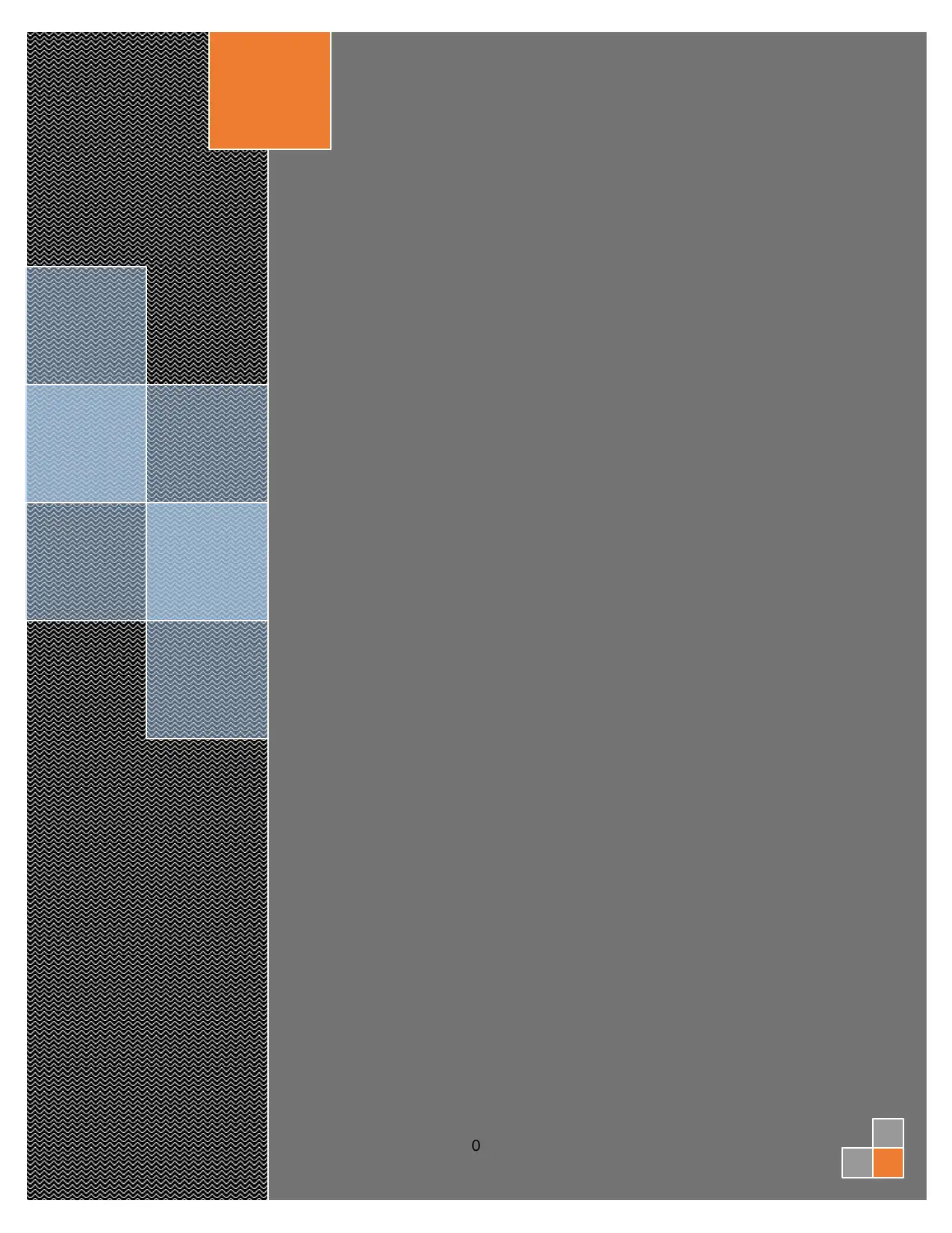
0
Paraphrase This Document
Need a fresh take? Get an instant paraphrase of this document with our AI Paraphraser
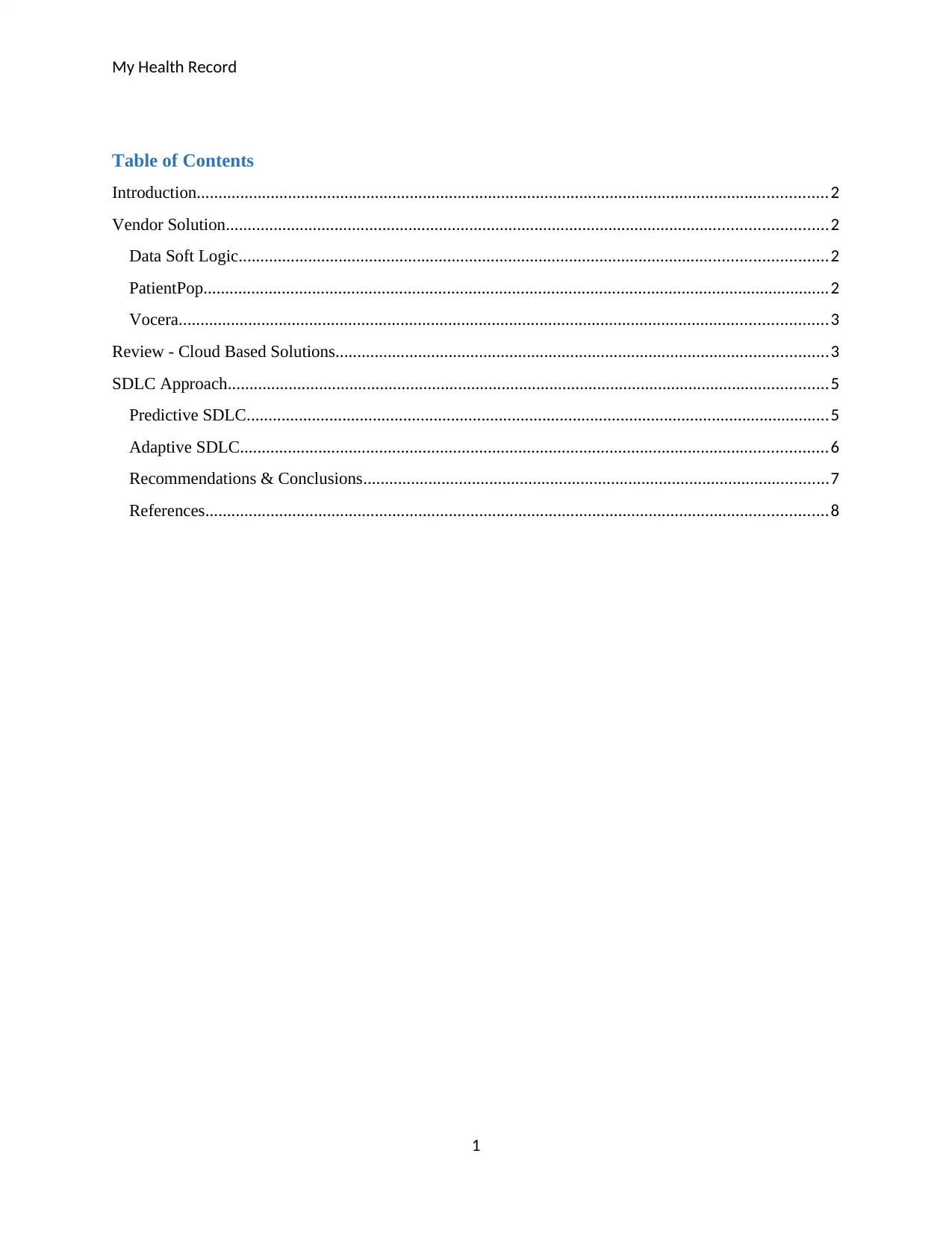
My Health Record
Table of Contents
Introduction.................................................................................................................................................2
Vendor Solution..........................................................................................................................................2
Data Soft Logic.......................................................................................................................................2
PatientPop................................................................................................................................................2
Vocera.....................................................................................................................................................3
Review - Cloud Based Solutions.................................................................................................................3
SDLC Approach..........................................................................................................................................5
Predictive SDLC......................................................................................................................................5
Adaptive SDLC.......................................................................................................................................6
Recommendations & Conclusions...........................................................................................................7
References...............................................................................................................................................8
1
Table of Contents
Introduction.................................................................................................................................................2
Vendor Solution..........................................................................................................................................2
Data Soft Logic.......................................................................................................................................2
PatientPop................................................................................................................................................2
Vocera.....................................................................................................................................................3
Review - Cloud Based Solutions.................................................................................................................3
SDLC Approach..........................................................................................................................................5
Predictive SDLC......................................................................................................................................5
Adaptive SDLC.......................................................................................................................................6
Recommendations & Conclusions...........................................................................................................7
References...............................................................................................................................................8
1

My Health Record
Introduction
My Health Record is an online health tool and system that has been designed to improve the state
of healthcare in Australia. The system stores the patient details and medical history and provides
the diagnosis and treatment on the basis of the information that is stored. The system has been
designed to be handled by the medical professionals to provide diagnosis as per the data sets.
However, there is certain security loopholes associated with the system as the information may
be accessed by the unauthorized entities as well.
Vendor Solution
Data Soft Logic
The proposed system may utilize Data Soft Logic as the vendor as it would provide the necessary
healthcare facilities with the required security settings. There is also a great deal of
customization that comes along with the software provided by the vendor.
Web-based system without the need of any installation or complicated configuration
99.9% availability and uptime of the cloud
Inclusion of all the clinical forms, such as PT, ST, OT, and many others
Secure and easy billing system for faster processing of the payments (Datasoftlogic,
2018)
Tracking and charting features along with the generation of alerts for the patients
Customized security settings
PatientPop
PatientPop is the vendor that provides the doctors and medical professionals with the integrated
set of tools and resources that may be required for providing health services to the patients.
The following features may be utilized for the proposed system.
Appoint confirmations and reminders for the medical professionals
Patient satisfaction surveys and feedback processes
Online scheduling for enhanced patient experience (Patientpop, 2018)
EMR Integration
2
Introduction
My Health Record is an online health tool and system that has been designed to improve the state
of healthcare in Australia. The system stores the patient details and medical history and provides
the diagnosis and treatment on the basis of the information that is stored. The system has been
designed to be handled by the medical professionals to provide diagnosis as per the data sets.
However, there is certain security loopholes associated with the system as the information may
be accessed by the unauthorized entities as well.
Vendor Solution
Data Soft Logic
The proposed system may utilize Data Soft Logic as the vendor as it would provide the necessary
healthcare facilities with the required security settings. There is also a great deal of
customization that comes along with the software provided by the vendor.
Web-based system without the need of any installation or complicated configuration
99.9% availability and uptime of the cloud
Inclusion of all the clinical forms, such as PT, ST, OT, and many others
Secure and easy billing system for faster processing of the payments (Datasoftlogic,
2018)
Tracking and charting features along with the generation of alerts for the patients
Customized security settings
PatientPop
PatientPop is the vendor that provides the doctors and medical professionals with the integrated
set of tools and resources that may be required for providing health services to the patients.
The following features may be utilized for the proposed system.
Appoint confirmations and reminders for the medical professionals
Patient satisfaction surveys and feedback processes
Online scheduling for enhanced patient experience (Patientpop, 2018)
EMR Integration
2
⊘ This is a preview!⊘
Do you want full access?
Subscribe today to unlock all pages.

Trusted by 1+ million students worldwide
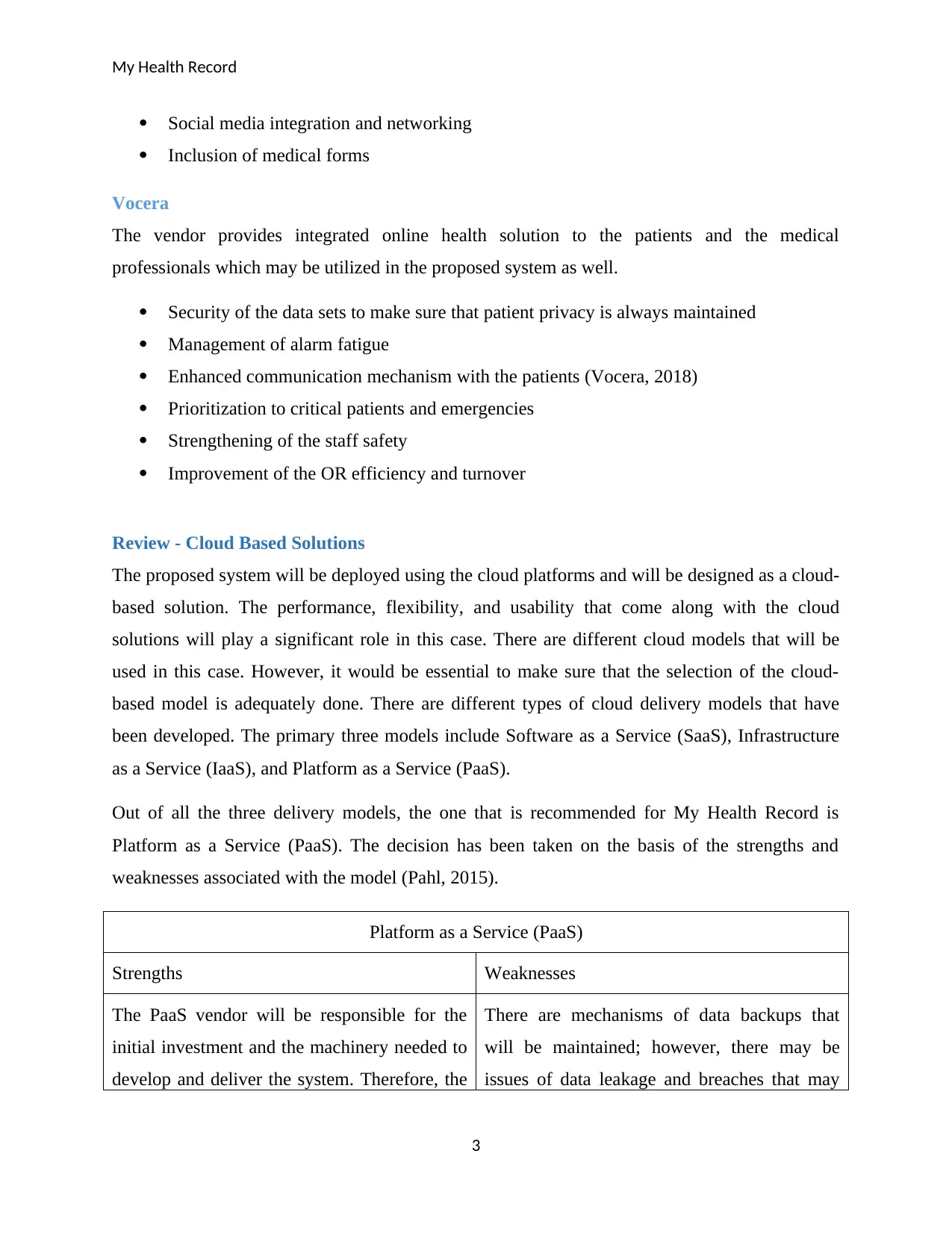
My Health Record
Social media integration and networking
Inclusion of medical forms
Vocera
The vendor provides integrated online health solution to the patients and the medical
professionals which may be utilized in the proposed system as well.
Security of the data sets to make sure that patient privacy is always maintained
Management of alarm fatigue
Enhanced communication mechanism with the patients (Vocera, 2018)
Prioritization to critical patients and emergencies
Strengthening of the staff safety
Improvement of the OR efficiency and turnover
Review - Cloud Based Solutions
The proposed system will be deployed using the cloud platforms and will be designed as a cloud-
based solution. The performance, flexibility, and usability that come along with the cloud
solutions will play a significant role in this case. There are different cloud models that will be
used in this case. However, it would be essential to make sure that the selection of the cloud-
based model is adequately done. There are different types of cloud delivery models that have
been developed. The primary three models include Software as a Service (SaaS), Infrastructure
as a Service (IaaS), and Platform as a Service (PaaS).
Out of all the three delivery models, the one that is recommended for My Health Record is
Platform as a Service (PaaS). The decision has been taken on the basis of the strengths and
weaknesses associated with the model (Pahl, 2015).
Platform as a Service (PaaS)
Strengths Weaknesses
The PaaS vendor will be responsible for the
initial investment and the machinery needed to
develop and deliver the system. Therefore, the
There are mechanisms of data backups that
will be maintained; however, there may be
issues of data leakage and breaches that may
3
Social media integration and networking
Inclusion of medical forms
Vocera
The vendor provides integrated online health solution to the patients and the medical
professionals which may be utilized in the proposed system as well.
Security of the data sets to make sure that patient privacy is always maintained
Management of alarm fatigue
Enhanced communication mechanism with the patients (Vocera, 2018)
Prioritization to critical patients and emergencies
Strengthening of the staff safety
Improvement of the OR efficiency and turnover
Review - Cloud Based Solutions
The proposed system will be deployed using the cloud platforms and will be designed as a cloud-
based solution. The performance, flexibility, and usability that come along with the cloud
solutions will play a significant role in this case. There are different cloud models that will be
used in this case. However, it would be essential to make sure that the selection of the cloud-
based model is adequately done. There are different types of cloud delivery models that have
been developed. The primary three models include Software as a Service (SaaS), Infrastructure
as a Service (IaaS), and Platform as a Service (PaaS).
Out of all the three delivery models, the one that is recommended for My Health Record is
Platform as a Service (PaaS). The decision has been taken on the basis of the strengths and
weaknesses associated with the model (Pahl, 2015).
Platform as a Service (PaaS)
Strengths Weaknesses
The PaaS vendor will be responsible for the
initial investment and the machinery needed to
develop and deliver the system. Therefore, the
There are mechanisms of data backups that
will be maintained; however, there may be
issues of data leakage and breaches that may
3
Paraphrase This Document
Need a fresh take? Get an instant paraphrase of this document with our AI Paraphraser

My Health Record
organization will not have to bear to burden of
huge initial investment in the primary stage of
the project.
come along on the information stored on the
cloud.
The overall costs will be reduced as the cost of
machinery will be eliminated and the
organization will pay only for the services and
platforms that will be utilized during the
project (Walraven, Truyen & Joosen, 2013).
The integration with the other systems and
components may come as an issue.
The updates will be installed by the PaaS
vendor as soon as the updates will be available.
This will reduce the probability of security
risks and attacks.
In case of the failure of cloud services, the
availability of the data may be impacted.
Agility and flexibility will be the two features
that will come easy with the PaaS model of the
cloud. The delivery will be quick and it will be
easier to incorporate any of the changes.
Customer captivity may be a problem.
The specific business requirements will be met
by maintaining reliability of the services and
information at the top priority
Service Level Agreement (SLA) may be
compromised.
Data backups will be scheduled and carried out
automatically making sure that the availability
of the system is never compromised
The flexibility that comes with PaaS does not
match up to the flexibility of IaaS-based
solutions (Singh & Kaur, 2013).
In case of technical risks and hardware failure,
the ownership and responsibility will be on the
PaaS vendor.
Lock-in to specific cloud environments
Internal entrepreneurship and dynamic
allocation of the resources
The level of customer satisfaction may be
impacted with the occurrence of security
attacks.
4
organization will not have to bear to burden of
huge initial investment in the primary stage of
the project.
come along on the information stored on the
cloud.
The overall costs will be reduced as the cost of
machinery will be eliminated and the
organization will pay only for the services and
platforms that will be utilized during the
project (Walraven, Truyen & Joosen, 2013).
The integration with the other systems and
components may come as an issue.
The updates will be installed by the PaaS
vendor as soon as the updates will be available.
This will reduce the probability of security
risks and attacks.
In case of the failure of cloud services, the
availability of the data may be impacted.
Agility and flexibility will be the two features
that will come easy with the PaaS model of the
cloud. The delivery will be quick and it will be
easier to incorporate any of the changes.
Customer captivity may be a problem.
The specific business requirements will be met
by maintaining reliability of the services and
information at the top priority
Service Level Agreement (SLA) may be
compromised.
Data backups will be scheduled and carried out
automatically making sure that the availability
of the system is never compromised
The flexibility that comes with PaaS does not
match up to the flexibility of IaaS-based
solutions (Singh & Kaur, 2013).
In case of technical risks and hardware failure,
the ownership and responsibility will be on the
PaaS vendor.
Lock-in to specific cloud environments
Internal entrepreneurship and dynamic
allocation of the resources
The level of customer satisfaction may be
impacted with the occurrence of security
attacks.
4

My Health Record
There are also a number of cloud deployment models that are available and one of these models
will be necessary for deploying the developed system. Three of the primary deployment models
include private cloud, public cloud, and hybrid cloud. The health information is extremely
sensitive and critical in nature. It is also required to abide by various regulations to make sure
that the privacy of the health details is always maintained. The users of the proposed health
applications will primarily be the patients and the medical professionals. In order to make sure
that the health information is protected and the users have ultimate experience, the proposed
cloud deployment model is hybrid cloud. It is the cloud model that is a combination of the public
and private cloud (Jenkins, 2014). The hybrid cloud model will meet the requirements of the
proposed system and will also be able to handle the security requirements at the top priority.
SDLC Approach
SDLC is an abbreviation for Software Development Lifecycle. It is the lifecycle that is followed
during the development of any program or software. There are primarily two categories of
development approaches that may be followed in the lifecycle. These include predictive SDLC
or adaptive SDLC.
Predictive SDLC
Predictive SDLC is the set of software development methodologies or approaches in which the
activities and processes are pre-defined. The procedure that will be followed in a project in terms
of phases and stages will depend upon the same flow and there is lesser scope of modification
that may be involved. It offers the advantages as
It is possible to predict the impact and the execution of the next phase as per this cycle.
Most of the plans and activities are planned in advance and a sequential order is usually
followed to execute the same.
It offers enhanced standardization
Waterfall model for software development is one of the methodologies that come under the
predictive SDLC category. It comprises of the phases as start-up, requirements analysis &
planning, design, development, testing & implementation, and maintenance (Okoli & Carillo,
2012).
5
There are also a number of cloud deployment models that are available and one of these models
will be necessary for deploying the developed system. Three of the primary deployment models
include private cloud, public cloud, and hybrid cloud. The health information is extremely
sensitive and critical in nature. It is also required to abide by various regulations to make sure
that the privacy of the health details is always maintained. The users of the proposed health
applications will primarily be the patients and the medical professionals. In order to make sure
that the health information is protected and the users have ultimate experience, the proposed
cloud deployment model is hybrid cloud. It is the cloud model that is a combination of the public
and private cloud (Jenkins, 2014). The hybrid cloud model will meet the requirements of the
proposed system and will also be able to handle the security requirements at the top priority.
SDLC Approach
SDLC is an abbreviation for Software Development Lifecycle. It is the lifecycle that is followed
during the development of any program or software. There are primarily two categories of
development approaches that may be followed in the lifecycle. These include predictive SDLC
or adaptive SDLC.
Predictive SDLC
Predictive SDLC is the set of software development methodologies or approaches in which the
activities and processes are pre-defined. The procedure that will be followed in a project in terms
of phases and stages will depend upon the same flow and there is lesser scope of modification
that may be involved. It offers the advantages as
It is possible to predict the impact and the execution of the next phase as per this cycle.
Most of the plans and activities are planned in advance and a sequential order is usually
followed to execute the same.
It offers enhanced standardization
Waterfall model for software development is one of the methodologies that come under the
predictive SDLC category. It comprises of the phases as start-up, requirements analysis &
planning, design, development, testing & implementation, and maintenance (Okoli & Carillo,
2012).
5
⊘ This is a preview!⊘
Do you want full access?
Subscribe today to unlock all pages.

Trusted by 1+ million students worldwide
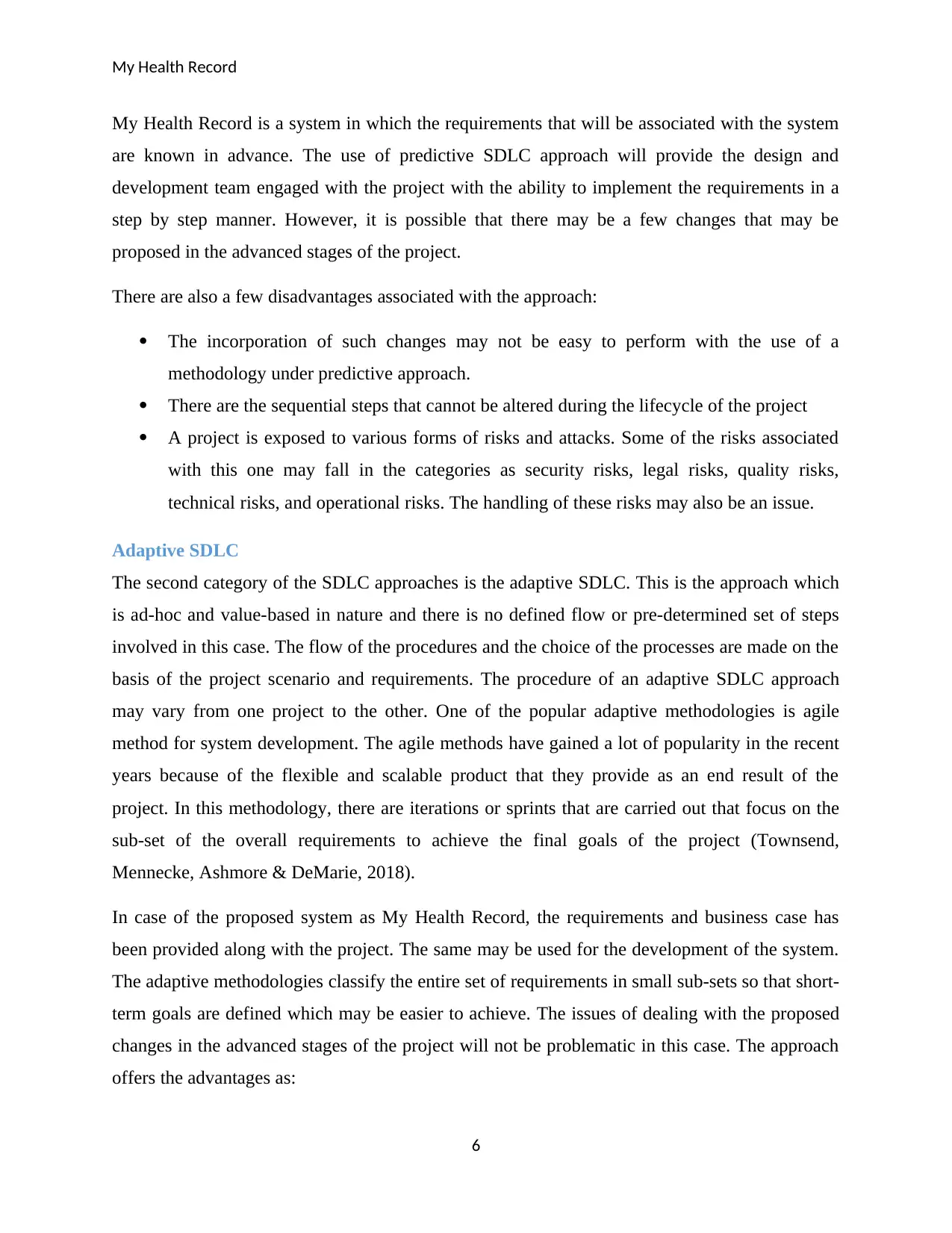
My Health Record
My Health Record is a system in which the requirements that will be associated with the system
are known in advance. The use of predictive SDLC approach will provide the design and
development team engaged with the project with the ability to implement the requirements in a
step by step manner. However, it is possible that there may be a few changes that may be
proposed in the advanced stages of the project.
There are also a few disadvantages associated with the approach:
The incorporation of such changes may not be easy to perform with the use of a
methodology under predictive approach.
There are the sequential steps that cannot be altered during the lifecycle of the project
A project is exposed to various forms of risks and attacks. Some of the risks associated
with this one may fall in the categories as security risks, legal risks, quality risks,
technical risks, and operational risks. The handling of these risks may also be an issue.
Adaptive SDLC
The second category of the SDLC approaches is the adaptive SDLC. This is the approach which
is ad-hoc and value-based in nature and there is no defined flow or pre-determined set of steps
involved in this case. The flow of the procedures and the choice of the processes are made on the
basis of the project scenario and requirements. The procedure of an adaptive SDLC approach
may vary from one project to the other. One of the popular adaptive methodologies is agile
method for system development. The agile methods have gained a lot of popularity in the recent
years because of the flexible and scalable product that they provide as an end result of the
project. In this methodology, there are iterations or sprints that are carried out that focus on the
sub-set of the overall requirements to achieve the final goals of the project (Townsend,
Mennecke, Ashmore & DeMarie, 2018).
In case of the proposed system as My Health Record, the requirements and business case has
been provided along with the project. The same may be used for the development of the system.
The adaptive methodologies classify the entire set of requirements in small sub-sets so that short-
term goals are defined which may be easier to achieve. The issues of dealing with the proposed
changes in the advanced stages of the project will not be problematic in this case. The approach
offers the advantages as:
6
My Health Record is a system in which the requirements that will be associated with the system
are known in advance. The use of predictive SDLC approach will provide the design and
development team engaged with the project with the ability to implement the requirements in a
step by step manner. However, it is possible that there may be a few changes that may be
proposed in the advanced stages of the project.
There are also a few disadvantages associated with the approach:
The incorporation of such changes may not be easy to perform with the use of a
methodology under predictive approach.
There are the sequential steps that cannot be altered during the lifecycle of the project
A project is exposed to various forms of risks and attacks. Some of the risks associated
with this one may fall in the categories as security risks, legal risks, quality risks,
technical risks, and operational risks. The handling of these risks may also be an issue.
Adaptive SDLC
The second category of the SDLC approaches is the adaptive SDLC. This is the approach which
is ad-hoc and value-based in nature and there is no defined flow or pre-determined set of steps
involved in this case. The flow of the procedures and the choice of the processes are made on the
basis of the project scenario and requirements. The procedure of an adaptive SDLC approach
may vary from one project to the other. One of the popular adaptive methodologies is agile
method for system development. The agile methods have gained a lot of popularity in the recent
years because of the flexible and scalable product that they provide as an end result of the
project. In this methodology, there are iterations or sprints that are carried out that focus on the
sub-set of the overall requirements to achieve the final goals of the project (Townsend,
Mennecke, Ashmore & DeMarie, 2018).
In case of the proposed system as My Health Record, the requirements and business case has
been provided along with the project. The same may be used for the development of the system.
The adaptive methodologies classify the entire set of requirements in small sub-sets so that short-
term goals are defined which may be easier to achieve. The issues of dealing with the proposed
changes in the advanced stages of the project will not be problematic in this case. The approach
offers the advantages as:
6
Paraphrase This Document
Need a fresh take? Get an instant paraphrase of this document with our AI Paraphraser

My Health Record
Any of the changes can be adequately handled.
The methodology will include customer involvement and feedback at regular intervals.
This is the feature that will enhance the user experience and the level of satisfaction.
The customers will be provided with the system modules in every stage and the feedback will be
obtained. The comments in the process of feedback will be incorporated in the subsequent
phases. As a result, the actual and expected values will not have any gaps.
There may be a few disadvantages as:
Lack of monitoring and control
Lack of standardization
Difficult to implement
Recommendations & Conclusions
The analysis is made on the basis of the requirements of the proposed system. My Health Record
is a system in which the requirements that will be associated with the system are known in
advance. However, it is possible that there may be a few changes that may be proposed in the
advanced stages of the project. On the basis of the system needs and requirements, the proposed
methodology is adaptive approach for system development. Agile methods may be used to
develop the system. The issues of dealing with the proposed changes in the advanced stages of
the project will not be problematic in this case. Also, the methodology will include customer
involvement and feedback at regular intervals. The cloud models that have been recommended
for the system are PaaS cloud and hybrid cloud. These models have been recommended because
of the need of data and information security and availability for the system along with the other
system requirements.
7
Any of the changes can be adequately handled.
The methodology will include customer involvement and feedback at regular intervals.
This is the feature that will enhance the user experience and the level of satisfaction.
The customers will be provided with the system modules in every stage and the feedback will be
obtained. The comments in the process of feedback will be incorporated in the subsequent
phases. As a result, the actual and expected values will not have any gaps.
There may be a few disadvantages as:
Lack of monitoring and control
Lack of standardization
Difficult to implement
Recommendations & Conclusions
The analysis is made on the basis of the requirements of the proposed system. My Health Record
is a system in which the requirements that will be associated with the system are known in
advance. However, it is possible that there may be a few changes that may be proposed in the
advanced stages of the project. On the basis of the system needs and requirements, the proposed
methodology is adaptive approach for system development. Agile methods may be used to
develop the system. The issues of dealing with the proposed changes in the advanced stages of
the project will not be problematic in this case. Also, the methodology will include customer
involvement and feedback at regular intervals. The cloud models that have been recommended
for the system are PaaS cloud and hybrid cloud. These models have been recommended because
of the need of data and information security and availability for the system along with the other
system requirements.
7
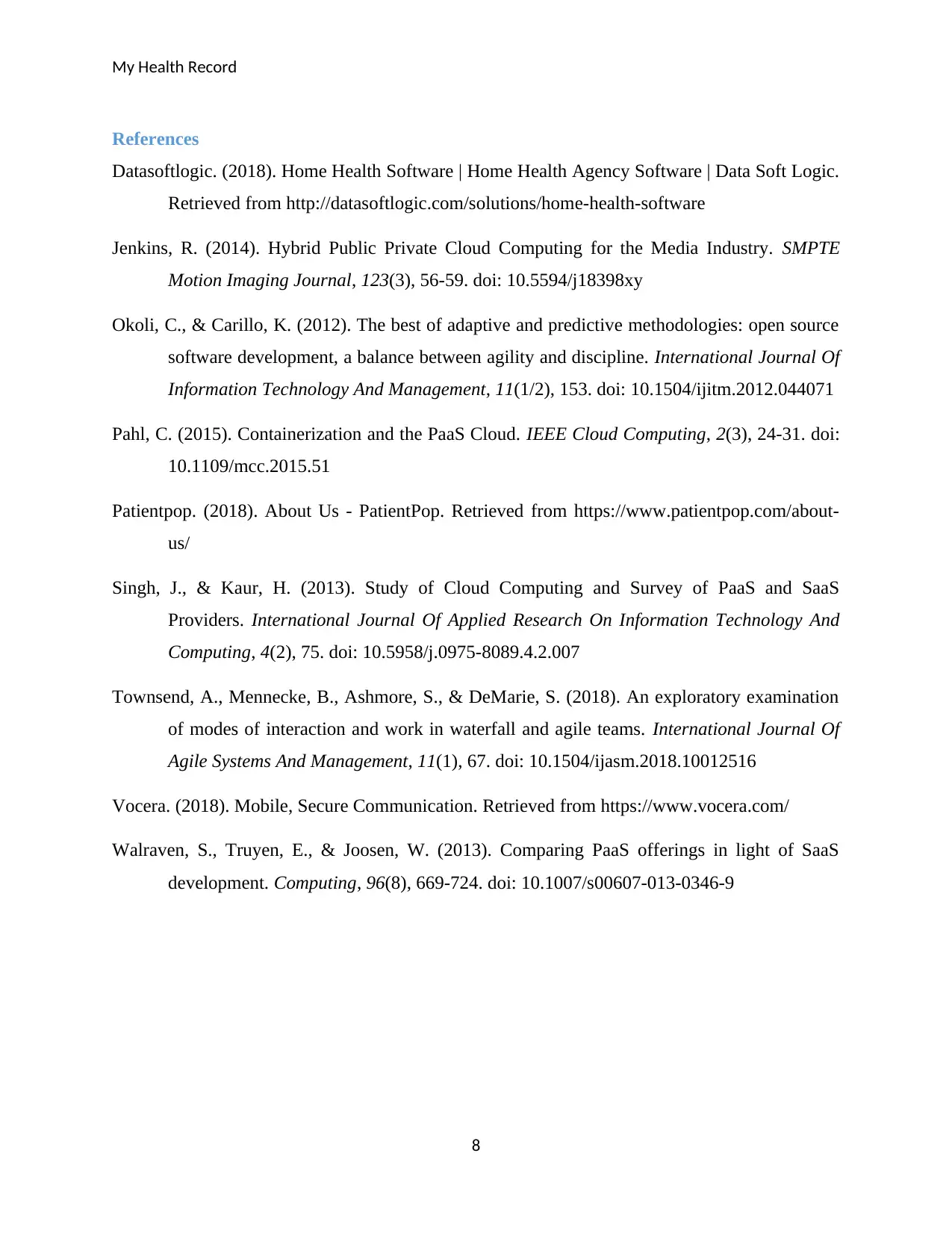
My Health Record
References
Datasoftlogic. (2018). Home Health Software | Home Health Agency Software | Data Soft Logic.
Retrieved from http://datasoftlogic.com/solutions/home-health-software
Jenkins, R. (2014). Hybrid Public Private Cloud Computing for the Media Industry. SMPTE
Motion Imaging Journal, 123(3), 56-59. doi: 10.5594/j18398xy
Okoli, C., & Carillo, K. (2012). The best of adaptive and predictive methodologies: open source
software development, a balance between agility and discipline. International Journal Of
Information Technology And Management, 11(1/2), 153. doi: 10.1504/ijitm.2012.044071
Pahl, C. (2015). Containerization and the PaaS Cloud. IEEE Cloud Computing, 2(3), 24-31. doi:
10.1109/mcc.2015.51
Patientpop. (2018). About Us - PatientPop. Retrieved from https://www.patientpop.com/about-
us/
Singh, J., & Kaur, H. (2013). Study of Cloud Computing and Survey of PaaS and SaaS
Providers. International Journal Of Applied Research On Information Technology And
Computing, 4(2), 75. doi: 10.5958/j.0975-8089.4.2.007
Townsend, A., Mennecke, B., Ashmore, S., & DeMarie, S. (2018). An exploratory examination
of modes of interaction and work in waterfall and agile teams. International Journal Of
Agile Systems And Management, 11(1), 67. doi: 10.1504/ijasm.2018.10012516
Vocera. (2018). Mobile, Secure Communication. Retrieved from https://www.vocera.com/
Walraven, S., Truyen, E., & Joosen, W. (2013). Comparing PaaS offerings in light of SaaS
development. Computing, 96(8), 669-724. doi: 10.1007/s00607-013-0346-9
8
References
Datasoftlogic. (2018). Home Health Software | Home Health Agency Software | Data Soft Logic.
Retrieved from http://datasoftlogic.com/solutions/home-health-software
Jenkins, R. (2014). Hybrid Public Private Cloud Computing for the Media Industry. SMPTE
Motion Imaging Journal, 123(3), 56-59. doi: 10.5594/j18398xy
Okoli, C., & Carillo, K. (2012). The best of adaptive and predictive methodologies: open source
software development, a balance between agility and discipline. International Journal Of
Information Technology And Management, 11(1/2), 153. doi: 10.1504/ijitm.2012.044071
Pahl, C. (2015). Containerization and the PaaS Cloud. IEEE Cloud Computing, 2(3), 24-31. doi:
10.1109/mcc.2015.51
Patientpop. (2018). About Us - PatientPop. Retrieved from https://www.patientpop.com/about-
us/
Singh, J., & Kaur, H. (2013). Study of Cloud Computing and Survey of PaaS and SaaS
Providers. International Journal Of Applied Research On Information Technology And
Computing, 4(2), 75. doi: 10.5958/j.0975-8089.4.2.007
Townsend, A., Mennecke, B., Ashmore, S., & DeMarie, S. (2018). An exploratory examination
of modes of interaction and work in waterfall and agile teams. International Journal Of
Agile Systems And Management, 11(1), 67. doi: 10.1504/ijasm.2018.10012516
Vocera. (2018). Mobile, Secure Communication. Retrieved from https://www.vocera.com/
Walraven, S., Truyen, E., & Joosen, W. (2013). Comparing PaaS offerings in light of SaaS
development. Computing, 96(8), 669-724. doi: 10.1007/s00607-013-0346-9
8
⊘ This is a preview!⊘
Do you want full access?
Subscribe today to unlock all pages.

Trusted by 1+ million students worldwide
1 out of 9
Related Documents
Your All-in-One AI-Powered Toolkit for Academic Success.
+13062052269
info@desklib.com
Available 24*7 on WhatsApp / Email
![[object Object]](/_next/static/media/star-bottom.7253800d.svg)
Unlock your academic potential
Copyright © 2020–2025 A2Z Services. All Rights Reserved. Developed and managed by ZUCOL.




